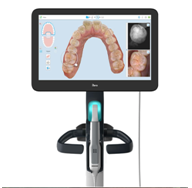The Future of Dentistry: How Intra-Oral Scanners Are Changing Your Dental Experience
If you’ve ever had a dental impression taken the traditional way, you’ll likely remember the experience. A tray filled with a thick, putty-like material is placed in your mouth, and you have to stay as still as possible while it sets. For some, it’s mildly uncomfortable; for others, it can trigger a strong gag reflex. It’s a process that has been used for decades.

But dentistry, like everything else, evolves. And one of the most exciting advances in modern dental care is the intra-oral scanner. As your dentist, I want to explain what this technology is, how it works, and why it’s such a game-changer for your dental experience.
What is an Intra-Oral Scanner?

An intra-oral scanner is a small, handheld device that allows us to create a highly accurate digital model of your teeth and gums. Instead of using traditional impression materials, the scanner captures a series of images using advanced optical technology, which are then processed to generate a 3D representation of your mouth.
The device itself is sleek and compact, designed to fit comfortably in your mouth without causing discomfort. It works by scanning your teeth in real time, which means that within minutes, we can produce a detailed digital model that can be used for everything from crowns and bridges to orthodontic aligners and dentures.
How Does It Improve Your Experience?
One of the most noticeable benefits for you as a patient is the immediate comfort. If you’ve ever struggled with impression materials in the past, you’ll be relieved to know that intra-oral scanning eliminates the need for them entirely. There’s no sticky mess, no awkward waiting time, and no risk of the impression distorting if you move slightly.
Beyond comfort, there’s also the matter of accuracy. Traditional impressions, while reliable, can be prone to small errors. If the material shifts or if there’s an air bubble, the impression might not be completely accurate. With digital scanning, we can capture a precise image of your teeth, reducing the chance of errors and ensuring a perfect fit for any dental work.
Another advantage is the speed. A traditional impression needs to be sent off to a dental laboratory, where technicians create a physical model before beginning work on your restoration. This process can take days or even weeks. With an intra-oral scanner, the digital model can be sent instantly to the lab, often reducing turnaround times significantly. In some cases, such as same-day crowns, the entire process can be completed in a single visit.
How Does It Help with Treatment Planning?

Beyond creating impressions for restorations like crowns and bridges, intra-oral scanners also allow us to monitor changes in your teeth over time. Because we have a digital record of your teeth, we can compare scans from different visits to track wear, movement, or early signs of problems such as gum recession or enamel erosion.
If you’re considering orthodontic treatment, such as clear aligners, the scanner plays a crucial role. Instead of relying on physical moulds, which can be less precise, we can create a fully digital treatment plan that shows exactly how your teeth will move over time. Many patients find this particularly exciting, as they can see a simulated preview of their future smile before even starting treatment.
Are There Any Downsides?
As with any technology, intra-oral scanners aren’t perfect. There are some limitations, such as the need for a clear and dry scanning environment. Excessive saliva or movement can sometimes cause distortions, meaning we may need to rescan certain areas. However, compared to the potential inaccuracies of traditional impressions, this is a minor inconvenience.
Some very complex cases may still require traditional impressions, especially if the scanner cannot reach a particularly tricky area of the mouth. But for the vast majority of patients, digital scanning is the preferred option.
A More Sustainable Option
Another aspect worth mentioning is the environmental impact. Traditional impressions involve a lot of disposable materials, from the impression trays to the putty and the plaster models that are later discarded. With intra-oral scanning, everything is digital, reducing waste significantly. In an age where sustainability is becoming more important, digital dentistry is a step in the right direction.
What This Means for You as a Patient
For you, the patient, the rise of intra-oral scanning means a more comfortable, efficient, and accurate dental experience. Whether you need a crown, a bridge, orthodontic treatment, or even just routine monitoring of your dental health, this technology makes the process smoother and more precise.
As a dentist, my goal is always to provide you with the best possible care, using the latest advancements to make your experience as stress-free as possible. If you have any questions about intra-oral scanning or how it might benefit you, feel free to ask at your next visit. The days of uncomfortable dental impressions are quickly becoming a thing of the past, and I, for one, am excited about the future of digital dentistry.
